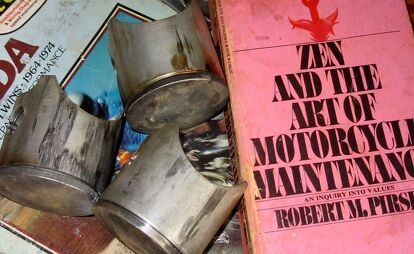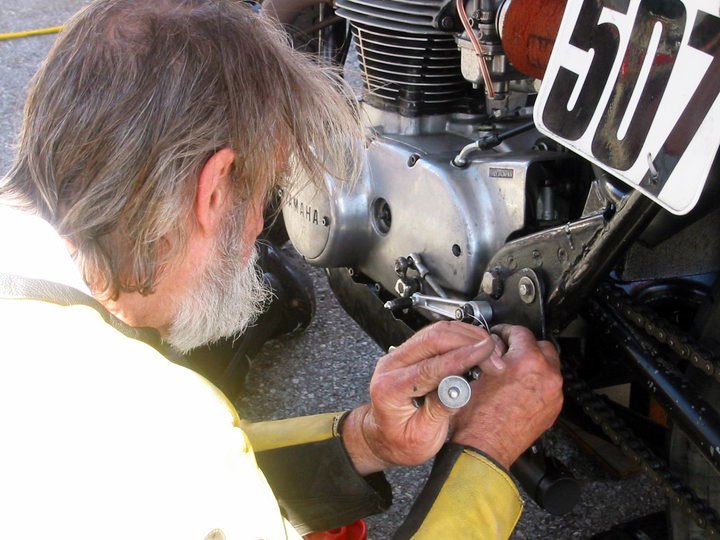Head Shake - The Wisdom of Robert M. Pirsig
A rider's guide to Zen and the Art of Motorcycle Maintenance
In the ’70s, while I was still bumbling my way through high school and establishing a glide path to academic doom, I had a teacher stop me on the way out the door, she wanted to talk to me. This was not unusual. What was unusual was that I was actually doing fairly well in her class, and I couldn’t imagine what she wanted to talk to me about. So, I stayed, she asked me the normal teacher questions, how are things going (Fine), how are the other classes going (Wretchedly), that sort of thing. Then she turned in her chair and grabbed a book off her personal bookshelf, she held it out to me saying she couldn’t wade through it but that I might get something out of it.
That book was Zen and the Art of Motorcycle Maintenance, An Inquiry Into Values by Robert M. Pirsig.
I had never heard of the book, but I was intrigued. Motorcycle maintenance, huh, Zen? What in the world do we have here? I don’t know why she did that, maybe because she knew I rode on the street and so few students did. Maybe she thought it would appeal to me. I don’t know. But I thanked her and took it.
I started reading it and it grabbed me like a Pocono front straight draft: a man and his son on a multistate motorcycle tour, and the man is searching for something, something that is not clear at first but becomes apparent by the end. And all along the way, a motorcycle plays a central role; sometimes as metaphor, sometimes in a very real world kind of way, but the bike was always in the picture. I was hooked.
I was so hooked I read it and reread it. It can be read on so many levels. I carried it with me throughout the Army, reading it again and again. I was astonished to find that, when I got out of the Army and was wandering through the college bookstore, I happened to trip across a shelf full of Zen and the Art. It was being offered in a class, Introduction to Ethics 101, with a man I came to know well over the years and respect a great deal, Dr. Alan Paskow. I resolved to take that class thinking I might have a leg up having read it so many times, and after my dismal high school experience, I needed all the help I could get. Little did I know that one class would set the course for my entire college experience and determine the direction of my next four years of study.
That high school teacher probably had no idea at the time how influential that book would be in my life, but it made all the difference. It’s funny, though, because I could have gotten discouraged early on. Pirsig wastes little time in the introduction noting:
“What follows is based on actual occurrences. Although much has been changed for rhetorical purposes, it must be regarded in its essence as fact. However, it should in no way be associated with that great body of factual information relating to orthodox Zen Buddhist practice. It’s not very factual on motorcycles, either.” – R. Pirsig
I could have been discouraged by that introduction back in high school but curiosity drove me on, and over the years, while I have come to understand what Pirsig meant in that statement – he covers a lot of ground in that book – it does indeed have a great deal to do with motorcycles and motorcycle maintenance. In fact, I’m not sure the story could have been told in the absence of that bike and his experience with it.
“In a car you’re always in a compartment, and because you’re used to it you don’t realize that through that car window everything you see is just more TV. You’re a passive observer and it is all moving by you boringly in a frame. On a cycle the frame is gone. You’re completely in contact with it all. You’re in the scene, not just watching it anymore, and the sense of presence is overwhelming.” – R. Pirsig
This is something we all know, even I knew this back in high school, and I certainly know it today. But everything Pirsig put in this book he put there for a reason. All through his road trip and this book, he is driving towards a point, a goal; he’s looking for answers. He starts with fundamentals to illustrate what comes later. If you ride, he is asking you to buy in because he knows you get it.
“The test of the machine is the satisfaction it gives you. There isn’t any other test. If the machine produces tranquility it’s right. If it disturbs you it’s wrong until either the machine or your mind is changed.” – R. Pirsig
I have seen this so many times I can’t see straight. I’ve ridden around bad suspension setups. I’ve nursed a two stroke prone to cold seizing around a track; you know when what you are riding is not right. Ergonomics could be all wrong, jetting, any number of things. When it is wrong it intrudes upon you, you are forced to think about the bike rather than what you should be thinking about; namely riding or racing. When things are perfect, the bike becomes an afterthought and does your bidding. Those are the perfect days on the track or the road. This is Pirsig’s jump-off point, one of many, to begin to flesh out some of his ideas.
Things do not magically become right all by themselves; somebody has to make them so. And the act of making them so is different than riding. In the former, you are asking what is good, does the bike feel right, is it working for you? In the latter, you are applying an analytical process to make them so; you are asking what is true. Using a degree wheel, or setting sag rates, or adjusting valve clearances; these are all things that have answers that are true, in many cases down to a decimal point involving tenths or less of an inch.
This is the nexus of two priorities, one of which seeks to know what is good? The ride? And one which looks to answer what is true? Check your tire pressures. I’m oversimplifying this out of necessity and space, but this is just a small part of where he is going. He is beginning to introduce the notions of what he terms romantic and classical schools of thought. You might call one subjective, the other objective or empirical, analytical, the science of motorcycling. What is good, and what is true. He is seeking to establish the relationship between the two. Imagine two team bikes with two different riders on the same track, they likely want two different setups – what is good. Their good may vary, but the process of achieving those ideal setups is the same; sag is sag, rear suspension height is rear suspension height, rebound, compression, all of that is what is true.
“Although motorcycle riding is romantic, motorcycle maintenance is purely classic.” – R. Pirsig
He is not one to get lost in the daisy fields, though. This is a man who is very familiar with riding, and he knows his way around a tool box. Nevertheless, the bike exemplifies the ideas he is trying to put forth.
“Other people can talk about how to expand the destiny of mankind. I just want to talk about how to fix a motorcycle. I think that what I have to say has more lasting value.” – R. Pirsig
This column does not have the space to do Robert Pirsig or his book justice. It would be entirely possible to write a book about the book, and I have barely scratched the surface. To really understand where Pirsig is going, you have to take the ride with him, maybe more than once. But I want to assure you if you love motorcycles, and long road trips, and maybe some headier things about the origins of Western thought, and values, and the evolution that took place to get from there to here – I urge you to pick up a copy and give it a go.
“Yah-da, yah-da, yah-da, yah-da, yah, carburetor, gear ratio, compression, yah-da-yah, piston, plugs, intake, yah-da-yah, on and on and on. That is the romantic face of the classic mode. Dull, awkward and ugly. Few romantics get beyond that point.” – R. Pirsig
All of this is much ado about a book that was first published in 1974, and while that certainly was a long time ago to some, the questions Pirsig grapples with date back to the pre-Socratics. They have not changed, and they are as timely now as they were in Plato’s time. You may, like my high school teacher – a hopeless romantic in a Pirsig sense – find yourself unable to get through it. That’s fine. It is not for everybody. But you may just find that it speaks to you in a profound way, and all along the way it is Pirsig, his son, and his bike shedding light on some very fundamental truths. The five million copies sold worldwide attest to its staying power. And yes, there is motorcycle maintenance in there and much more. I will leave you with one more Pirsig truism before I’m done, and good advice from a man who claims not to talk a great deal about motorcycle maintenance.
“Buy good tools as you can afford them and you’ll never regret it. If you want to save money don’t overlook the newspaper want ads. Good tools, as a rule, don’t wear out, and good secondhand tools are much better than inferior new ones.” – R. Pirsig
Enjoy the ride, be safe, look where you want to go.
About the Author: Chris Kallfelz is an orphaned Irish Catholic German Jew from a broken home with distinctly Buddhist tendencies. He hasn’t got the sense God gave seafood. Nice women seem to like him on occasion, for which he is eternally thankful, and he wrecks cars, badly, which is why bikes make sense. He doesn’t wreck bikes, unless they are on a track in closed course competition, and then all bets are off. He can hold a reasonable dinner conversation, eats with his mouth closed, and quotes Blaise Pascal when he’s not trying to high-side something for a five-dollar trophy. He’s been educated everywhere, and can ride bikes, commercial airliners and main battle tanks.
More by Chris Kallfelz




































Comments
Join the conversation
Very cool article, I was drawn here by the image of the book. I have been searching far and wide for this exact edition..the edition featuring the little holding hands image on the bottom of the spine (assuming that is what i can see in your pic). I know its an odd request but would you mind telling me what edition it was?
lovely analysis, and a reminder that it is time to read it again.